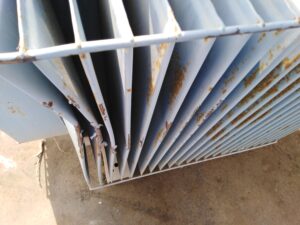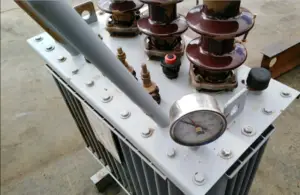Transformers generate a lot of heat due to copper and iron losses. To keep the temperature under control, cooling systems are installed to dissipate this heat.
If the cooling system fails, the heat will start to build up inside the transformer, leading to a host of problems. The increased heat causes more gas pressure to build up inside, which can result in the transformer bursting.
Furthermore, the excessive heat can speed up the degradation of insulating materials such as oil, paper, and pressboard, leading to reduced transformer lifespan and potentially catastrophic failure.
The cooling system of a transformer plays a crucial role in maintaining its operating temperature within the safe limit.
In this article, we will discuss the causes of transformer cooling system failure, the symptoms of cooling system failure, and the best practices for maintenance.
Table of Contents
Causes of Transformer Cooling System Failure:
The cooling system of a transformer can fail due to several reasons. Some of the common causes are:
- Lack of Maintenance: Regular maintenance of the transformer cooling system is necessary to ensure that the system is functioning correctly. Failure to maintain the system can lead to clogged or dirty cooling channels, causing the transformer to overheat and fail.
- Aging: Transformers have a limited lifespan, and as they age, their cooling system’s effectiveness decreases. This can result in overheating and failure of the transformer.
- Overloading: Overloading a transformer can cause it to generate more heat than its cooling system can dissipate, leading to failure.
- Poor Design: A poorly designed cooling system may not be capable of effectively dissipating the heat generated by the transformer, leading to overheating and failure.
Ready to dive in? Check out my comprehensive article about When transformer go bad, the top causes, now
Symptoms of Transformer Cooling System Failure:
The following are some of the common symptoms of transformer cooling system failure:
- High Temperature: A sudden increase in the transformer’s operating temperature can be a sign of cooling system failure. Red my article Transformer temperature rise explained. for more information.
- Oil Leakage: The cooling system of a transformer relies on oil for effective heat dissipation. If there is an oil leak, the cooling system’s effectiveness will be reduced, leading to overheating and failure.
- Noise: If the cooling system is not functioning correctly, the transformer may produce unusual noise.
- Reduced Efficiency: An inefficient cooling system can reduce the transformer’s efficiency and cause it to consume more energy than necessary.
Best Practices for Maintenance:
To ensure the efficient and safe operation of a transformer, the following best practices should be followed for maintenance:
- Regular Inspection: Regular inspection of the transformer and its cooling system is necessary to identify any potential problems before they become serious.
- Cleanliness: The cooling system should be kept clean and free of debris to ensure optimal heat dissipation. Make sure noo birds nests are exist between cooling fins.
- Oil Level: The oil level in the transformer should be regularly checked and maintained at the recommended level.
- Temperature Monitoring: The transformer’s temperature should be continuously monitored to detect any abnormal changes.
- Timely Repairs: Any faults in the cooling system or transformer should be repaired promptly to prevent further damage.
examples of transformer cooling system failures:

- Cooling Fans Failure: Many transformers use cooling fans to dissipate heat. If the fans fail due to motor failure, bearing wear, or electrical issues, the cooling system’s effectiveness will be reduced, leading to overheating and failure.
- Blocked Cooling Channels: Cooling channels inside the transformer that carry coolant can become blocked due to sludge buildup, sedimentation, or debris. This can restrict coolant flow, leading to overheating and failure.
- Pump Failure: In some transformers, pumps are used to circulate coolant through the cooling system. If the pump fails, the coolant flow will stop, leading to overheating and failure.
- Low Oil Level: The cooling system of a transformer relies on oil to dissipate heat. If the oil level is low due to leakage, the cooling system’s effectiveness will be reduced, leading to overheating and failure.
- Malfunctioning Temperature Sensors: Temperature sensors are used to monitor the transformer’s operating temperature. If the sensors malfunction or fail, the cooling system’s effectiveness may be compromised, leading to overheating and failure.
Conclusion:
The cooling system of a transformer is critical for its safe and efficient operation. Failure of the cooling system can result in overheating and eventual failure of the transformer.
Regular maintenance, including inspection, cleaning, and temperature monitoring, can help prevent cooling system failure.
Early detection of cooling system failure symptoms such as high temperature, oil leakage, noise, or reduced efficiency can help prevent more severe damage.
Don’t Leave Empty-Handed!
Install my Free Android App on Google Play:
Electrical Cables Most Common Tables “Cables Tables”
And, my Electrical Calculations App “Fast Electrical Calculator”
Discover more great content by subscribing to My channel
Looking to stay ahead of the game in the world of electrical engineering? Subscribe to my YouTube channel and gain access to exclusive content you won’t find anywhere else!
The staff I recommend
(Amazon Affiliate Links to products I believe are high quality):
- Economy 120 Volt/60Hz AC Power Source – Step-Down Voltage & Frequency Converters 1800W
- UNI-T Digital Multimeter Tester UT139C
- 50-Amp Extension Cord for RV “100ft”
- Voltage Stabilizer 110/220v
- Hair Dryer “best selling“
- TOSHIBA EM131A5C-BS Countertop Microwave Ovens
Disclaimer: This contains affiliate links to Amazon products. I may earn a commission for purchases made through these links.


